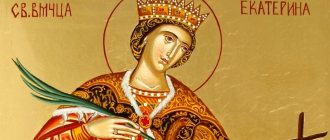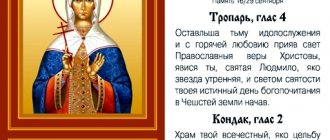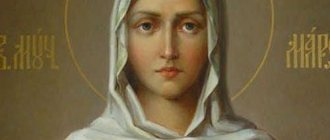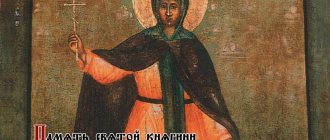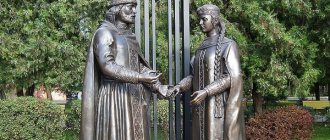The Day of the Holy Great Martyr Catherine is celebrated annually on December 7. Find out what this saint is famous for, what prayers women turn to her with, who she patronizes, what signs exist among the people. And don’t forget to congratulate all your friends Katerina and Katyusha on this bright holiday. And we have selected the most heartfelt poems, SMS and postcards for you!
The Holy Great Martyr Catherine of Alexandria is equally revered by both the Orthodox and Catholic churches. The story of the Holy Great Martyr Catherine is dramatic and filled with deep meaning for all believers.
Saint Catherine was born in Alexandria, in the second half of the third century, into a family of noble and respected people. The girl not only had rare beauty, but was also famous for her sharp mind and desire for knowledge. She received an excellent education, studied the works of prominent figures in science, medicine and philosophy, knew foreign languages, and practiced oratory.
Many noble young men sought the favor of a beautiful and learned girl, but Catherine had a vision in which she saw herself as the bride of Jesus. The story of how Catherine receives a ring from Christ became a favorite subject of Renaissance artists: Raphael, Veronese, Bertucci and other great artists left us many paintings where they captured the image of St. Catherine.
For her adherence to Christianity, Emperor Maximillian subjected Saint Catherine to cruel torture and execution by beheading. The day of remembrance of the Holy Great Martyr Catherine is celebrated on December 7.
Saint Catherine - who does she patronize?
During her lifetime, Saint Catherine was known as a girl of brilliant education, deep intelligence and spiritual strength, therefore Christians consider her the patroness of knowledge.
Many educational institutions consider St. Catherine as their patroness. teachers and students traditionally ask for the saint’s support .
People whose work involves making difficult decisions ( legislative authorities, judges, prosecutors , etc.) also turn to the Holy Great Martyr Catherine with prayers for clarification of the situation and gaining spiritual clarity.
The Holy Great Martyr Catherine was the daughter of the ruler of Alexandria of Egypt, Constus, during the reign of Emperor Maximin (305 - 313). Living in the capital, the center of Hellenic learning, Catherine, who had rare beauty and intelligence, received an excellent education, having studied the works of the best ancient philosophers and scientists. Young men from the most eminent families of the empire sought the hand of the beautiful Catherine, but not one of them became her chosen one. She announced to her parents that she agreed to marry only someone who surpassed her in nobility, wealth, beauty and wisdom.
Catherine's mother, a secret Christian, took her for advice to her spiritual father, a holy elder, who performed a feat of prayer in solitude in a cave not far from the city. After listening to Catherine, the elder said that he knew a Youth who surpassed her in everything, for “His beauty is brighter than the sun’s radiance, His wisdom governs all creation, His wealth is spread throughout the world, but this does not reduce it, but multiplies it, the height of His family - indescribable." The image of the Heavenly Bridegroom gave birth in the soul of the holy virgin to an ardent desire to see Him. The truth to which her soul was yearning was revealed to her. At parting, the elder handed Catherine an icon of the Mother of God with the Infant Jesus in her arms and ordered her to pray with faith to the Queen of Heaven, the Mother of the Heavenly Bridegroom, for the granting of a vision of Her Son.
Catherine prayed all night and was honored to see the Most Holy Virgin, who asked Her Divine Son to look at Catherine kneeling before Them. But the Child turned His face away from her, saying that He could not look at her, because she was ugly, ugly, poor and insane, like every person who had not been washed by the waters of holy Baptism and not sealed with the seal of the Holy Spirit. In deep sadness, Catherine again went to the elder. He accepted her with love, instructed her in the faith of Christ, commanded her to maintain purity and chastity and to pray unceasingly, and performed the sacrament of holy Baptism over her. And again Saint Catherine had a vision of the Most Holy Theotokos with the Child. Now the Lord looked at her tenderly and gave her a ring, betrothing her to Himself. When the vision ended and the saint awoke from sleep, a ring shone on her hand - a wondrous gift from the Heavenly Bridegroom.
At this time, Emperor Maximin himself arrived in Alexandria for a pagan festival. On this occasion the holiday was especially magnificent and crowded. The cries of sacrificial animals, the smoke and stench of the altars, which burned incessantly, and the hubbub of the crowds on the lists filled Alexandria. Human sacrifices were also made - confessors of Christ who did not retreat from Him under torture were doomed to death in fire. Holy love for the Christian martyrs and a heartfelt desire to alleviate their lot prompted Catherine to go to the chief priest and ruler of the empire, the persecuting emperor Maximin.
Having identified herself, the saint confessed her faith in the One True God and wisely exposed the errors of the pagans. The beauty of the girl captivated the ruler. To convince her and show the triumph of pagan wisdom, the emperor ordered to convene 50 of the most learned men of the empire, but the saint prevailed over the wise men, so that they themselves believed in Christ. Saint Catherine made the sign of the cross over the martyrs, and they courageously accepted death for Christ and were burned by order of the emperor.
Maximin, no longer hoping to convince the saint, tried to seduce her with the promise of wealth and fame. Having received an angry refusal, the emperor ordered the saint to be subjected to cruel torture and then thrown into prison. Empress Augusta, who had heard a lot about Saint Catherine, wished to see her. Having persuaded the governor Porfiry with a detachment of soldiers to accompany her, Augusta came to the dungeon. The Empress was amazed by the strength of spirit of Saint Catherine, whose face shone with Divine grace. The holy martyr revealed Christian teaching to those who came, and they, believing, turned to Christ.
The next day, the martyr was again brought to the trial seat, where, under the threat of being thrown on the wheel, she was asked to renounce the Christian faith and make a sacrifice to the gods. The saint adamantly confessed Christ and herself approached the wheels, but an Angel crushed the instruments of execution, and they scattered into pieces, killing many pagans. Seeing this miracle, Empress Augusta and courtier Porfiry with 200 soldiers confessed their faith in Christ in front of everyone and were beheaded. Maximin again tried to seduce the holy martyr by offering her marriage, and again received a refusal. Saint Catherine firmly confessed allegiance to her Heavenly Bridegroom, Christ, and with a prayer to Him she herself laid her head on the block under the executioner’s sword. The relics of Saint Catherine were transferred by Angels to Mount Sinai. In the 6th century, by revelation, the venerable head and left hand of the holy martyr were found and transferred with honor to the newly created temple of the Sinai Monastery, built by the holy emperor Justinian.
Saint Catherine, who is the patroness of sciences, knowledge and learning, crafts and mining, brides and grooms, is a very revered Christian saint in the world. Her Christian feat is sung in prayers, poems and songs. Her wondrous image is depicted not only in icons, but also in paintings by outstanding artists of the Renaissance.
Saint Catherine was one of the most educated people of her time, which is why many educational institutions consider her their patroness. Among them are the colleges of Cambridge and Oxford, which bear the name of St. Catherine.
Teachers and students can turn to Saint Catherine so that she can help them achieve success in their chosen endeavor, in acquiring knowledge and enlightenment.
At the beginning of 1723, on the banks of the Iset River, construction began on a fortress plant for processing copper and iron ore. Two months before the imperial decree, on October 1, 1723, on the left bank of the Iset, not far from the dam, the foundation stone of the first church of the plant under construction was consecrated in honor of the Holy Great Martyr Catherine.
Foreseeing a city on the banks of the Iset River under the patronage of St. Catherine, the founding fathers of Yekaterinburg made the city-forming mining the subject of her care - this was eloquently evidenced by the city’s first and only mountain cathedral, Catherine’s Cathedral, blown up in 1930 and now awaiting restoration.
All over the world, prayers are offered to Saint Catherine for the protection of marriage, for good brides and grooms, as well as during difficult childbirths.
In Europe, on St. Catherine's Day, young girls who had not yet found their soulmate went to churches to renew the headdress on statues of the saint and decorate it with ribbons and flowers. Balls organized in honor of the saint were also traditional, where unmarried beauties - “katerinettes” - came dressed in unusual headdresses.
In Russia, before the revolution, on St. Catherine's Day: young people rode a sleigh drawn by a decorated horse, looked closely at brides and grooms to celebrate their wedding on the winter meat-eating day (from the Winter Wedding to Maslenitsa).
Troparion of the Great Martyr Catherine , tone 4
With virtues, like the rays of the sun, you enlightened the unfaithful sages, and, like the bright moon walking in the night, you drove away the darkness of unbelief and you convinced the queen, and you also exposed the tormentor, / the God-called bride, blessed Catherine, with desire you ascended into the Heavenly palace to to the beautiful Bridegroom Christ, and from Him you were crowned with a royal crown: To Him also, with the angels ahead, pray for us, creating your most honorable memory.
Kontakion of the Great Martyr Catherine, tone 2
Raise up an honest Divine face, martyr-lovers, now, in reverence to the all-wise Catherine, for this was the sermon at the funeral feast of Christ and trampled upon the serpent, having tamed the minds of the rhetoricians.
Kontakion of the Great Martyr Catherine, tone 3
Who are waving today, Catherine the martyr, and to the wreaths, denounce the harmful heresy, for an angel came from Heaven to that one, bringing power from the Most High, having received it, courageously speaking: Christ is a martyr's praise.
Prayer to the Great Martyr Catherine for good suitors
Oh, holy Great Martyr Catherine, the chosen vessel of purity, the pillar of Orthodoxy, our reliable intercessor, who showed us the guilt of begging you, a legal ascetic, a saint resting holy on a holy mountain! We pray to you: having come down from above, listen to the voice of our prayer, look at the misfortune of your servants, enlighten the darkness of our mind, make us wise in heaven, not earthly. Hasten with your prayers to overcome carnal lusts, addictions to the world and the machinations of evil spirits who are viciously fighting against us: so that through your intercession in the days of this life we will be free from their hostile attacks and after the end from their aerial tortures. Oh, wise maiden! Grant us everything that is useful for asking: you can ask much from your beloved Bridegroom, Christ our God. We know that the prayer of the righteous can do much, promoted by the compassion of the merciful God, to whom be glory, honor and thanksgiving always, now and ever, and unto the ages of ages. Amen.
Brief description of the life of the Great Martyr Catherine
The Day of the Holy Great Martyr Catherine is celebrated on December 7 (November 24, old style). On this holiday, all Christians honor the feat of the great saint in the name of faith.
The saint is originally from Alexandria. During her lifetime, she was famous as a very smart, beautiful and wealthy woman. Having adopted Christianity in 304, she was a preacher of the faith and teachings of Christ.
Emperor Maximilian, an ardent opponent of Christianity, tried in various ways to force Catherine to renounce her faith and convert to paganism. She was kept in prison without water or food, beaten until her body became like a continuous wound, tortured, tied to wheels with sharp teeth, and her head was cut off with a sword.
The girl’s suffering and persistent faith in the teachings of Jesus Christ led many pagans of that time to renounce their faith and become pious Christians.
The remains of Catherine are considered a great shrine for all Christians; they can be venerated on Mount Sinai, in the monastery that bears her name.
Tourists can still see the place where Catherine was executed when visiting Alexandria. Many churches and temples have been erected in honor of the great martyr all over the world, particularly in Russia.
St. Catherine's Day - folk signs
St. Catherine's Day has always been considered prophetic for the fate of every girl. The women asked the saint for peace in the family and a happy marriage. That’s why in the old days, on this day, girls told fortunes about their betrothed and gathered together for gatherings.
- If the weather on Catherine is clear, you should prepare for a frosty winter.
- Warm weather - frosts will strike only on Varvarin Day (after December 17).
- Thaw and fog forecast frost in 10 days.
- If snow falls on dry ground, the next year will be a poor harvest.
- Circles around the Moon foreshadow frost.
- Small stars in the sky predict snowfall.
The Life of Saint Catherine, Patroness of Love and Marriage
According to the biography of St. Catherine, the year of her birth is 287. She was born in Alexandria (Egypt today) into a noble family. Since childhood, Catherine’s mother instilled a love for Christianity. The legend says: a few days after baptism, Catherine had a dream in which Jesus Christ himself gave her a ring and called her his bride. After that, she rejected all proposals from suitors and even refused to Emperor Maximinus himself.
Catherine told people about Christianity, explained the Word of God, and studied the Holy Scriptures. She had a beautiful appearance and a sharp mind. Maximin could not come to terms with the fact that she refused him. He also did not forgive Catherine for her refusal to worship idols and ordered her to be tortured. She was in prison, then tortured with a wheel rotating in different directions. Ultimately, Catherine was decapitated.
St. Catherine's Day - what not to do
It should be noted that almost all the prohibitions on St. Catherine’s Day are not directly related to the holiday itself on December 7th. All believers know that the Nativity Fast is in effect. Of course, the girls had parties, got together and walked. But, for example, the table can only be set with permitted dishes, and these were porridge and borscht. And dancing on St. Catherine's Day is prohibited by fasting. Of course, any work on the land or physical labor was excluded. It was impossible to build, repair or sew anything. It should be noted that on St. Catherine’s Day you can tell fortunes, and almost everyone did this - both girls and boys. The most common way was to pull out a cherry branch and put it in a vase before Christmas. If she dissolved, it meant that the marriage would be very successful and happy.
Traditions and prayers
The main tradition on December 7 for believers was sleigh rides . To do this, they harnessed horses decorated with multi-colored ribbons and drove along a wide road with songs and jokes. Children and youth sledded down the hill. During such folk festivities, it was customary to look for brides, choosing the most ruddy ones. Girls also looked closely at the guys and hoped for a good marriage.
We recommend: Advantages and disadvantages of a wedding in December. Description of signs: on what dates is it better to get married?
It was also customary to pay special attention to the newlyweds on Catherine's Day. A festive dinner was prepared for them, to which they arrived in horse-drawn sleighs.
On this day, many girls told fortunes about their betrothed, baked loaves to attract him , but the church does not approve of this, but calls for prayers to honor the saint.
On the day of the Great Martyr Catherine, the girls prayed to the saint to protect them from all kinds of evil. Unmarried girls asked to send worthy grooms. And married women said prayers to protect the family from adversity, while pregnant women asked for an easy delivery.
Reference . It is generally accepted that a prayer to Catherine on December 7 will give the desired baby to families suffering from infertility.
St. Catherine's Day - congratulations on the holiday in prose
Dear Katyusha, I congratulate you on St. Catherine’s Day. May her bright name protect you from failures in life. Let it become a guiding star, leading you along the smooth and wide road of fate to success, happiness and prosperity!
***
Congratulations on the bright and blessed holiday of St. Catherine! May Saint Catherine never leave you, help you, guide you in everything, and protect you from troubles! I wish you true happiness, patience in difficult periods, strong faith in your soul, pure thoughts and a calm path in life!
***
I cordially congratulate you on St. Catherine's Day. May your angel protect you from adversity, sing good songs when you are sad and give you hope when your heart is anxious. I wish you great willpower, I wish you true happiness and joy, I wish you to continue your path in life with sincere faith and the good light of your soul.
Ekaterina: the meaning of the name
The name Catherine itself came from Byzantium. The root of the word is “katarios” (purity), hence the translation from ancient Greek – “immaculate”, “pure”. In the 11th-12th centuries, the name Ekaterina was already found as Katerina, and later, for ease of communication, it was shortened to Katya. Europe also has its own form - Katrina, Katrein, Catalina.
The Order of St. Catherine was established by Peter I in memory of the victory over the Turks and was (and is still considered) the highest award for women.
An interesting fact is that in 1797, according to the new statute, princes were awarded the Order of St. Andrew the First-Called, which was worn on a blue ribbon, and ladies were awarded the Order of St. Catherine, which was customary to be worn on a red ribbon. And immediately after baptism, boys were girded with a blue (St. Andrew’s) ribbon, and girls with a red (Catherine’s) ribbon. The custom of tying babies with different ribbons quickly took root among the nobility; later the tradition took root and has survived to this day.
Happy St. Catherine's Day - congratulations in verse
December 7 is the Day of St. Catherine, the Holy Martyr and the Bride of Christ. And today is your holiday, name day, and your loved ones and relatives will gather together. Let the saint protect you from the glances of evil and envious people. And today I wish you to achieve everything, overcome everything!
***
Happy St. Catherine's Day, I sincerely congratulate you, May troubles pass by, And may your soul shine with light. May the Saint protect you from illness, grief and evil, and may the angel guide you and protect you always!

